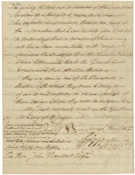Scenes From Hell
Gen. George Washington - A Threat of Bioterrorism, 1775
Bioterrorism was among the many concerns that occupied Gen. George Washington in the winter of 1775, six months after taking command of the ragtag American forces in Cambridge, Massachusetts. The years of the American Revolution coincided nearly perfectly with a smallpox epidemic that spanned the North American continent claiming more than 130,000 lives from 1775 to 1782. And Washington had reason to believe that the British were waging germ warfare by deliberately infecting American troops with the highly contagious and deadly smallpox virus.
Washington knew firsthand the misery of the disease having survived a smallpox infection years earlier; he was well aware that a smallpox epidemic would ravage his fledgling armies. It is impossible to know with certainty whether the British practiced germ warfare against the Americans or not. However, a series of letters from Washington to Congress written in December 1775 reveal that the threat of biological warfare was sufficiently real in his mind to merit mention in his official reports. First, his fears were based on a report that he heard and then fuelled by what he saw with his own eyes.
Letter from Gen. George Washington to John Hancock, President of Congress, regarding an alleged plot of the British to spread smallpox among the American troops, December 4, 1775, signature page
Before closing a lengthy letter to Congress reporting on a variety of topics, Washington passed along information that he had heard from a sailor: that British Gen. William Howe was sending people out from Boston who had been deliberately infected with smallpox so that they might pass on the disease to the Americans surrounding the city. After seeing an increased number of cases in people coming out of Boston, Washington came to believe that smallpox was indeed “a weapon of Defence they Are useing against us.”
National Archives, Records of the Continental and Confederation Congresses and the Constitutional Convention
Excerpt:
“By recent information from Boston, Genl Howe is goeing to Send out a number of the Inhabitants in order it is thought to make more room for his expected reinforcements, there is one part of the information that I Can hardly give Credit to. A Sailor Says that a number of these Comeing out have been innoculated, with design of Spreading the Smallpox thro’ this Country & Camp. I have Communicated this to the General Court & recommended their attention thereto.”
—From George Washington’s letter to Congress
.
George Washington, painting by Charles Willson Peale, 1776
In this portrait, General Washington is shown on Dorchester Heights after the siege of Boston.
Courtesy of the White House Historical Association (White House Collection), Washington, DC
.
Washington at Cambridge, taking command of the Army, 1775, print by Charles Stanley Reinhart, 1875
Courtesy of the Picture Collection, The Branch Libraries, The New York Public Library, New York City, Astor, Lenox and Tilden Foundations
.


